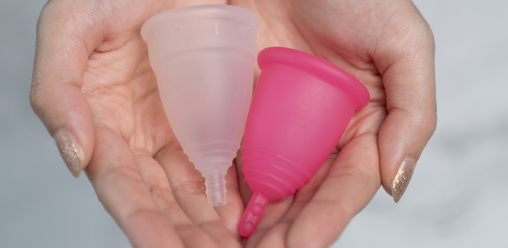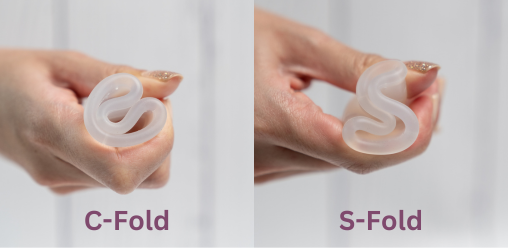Healthy New Jersey
Menstrual cups
Key facts about menstrual cups:
- Menstrual cups are reusable and environmentally friendly.
- They are typically made with medical-grade sillicone or latex.
- Empty and clean your menstrual cup every 4-12 hours.
- Similar to tampons, menstrual cups do not change your virginity.

Menstrual cups
Menstrual cups are a reusable, reliable, and sustainable period product. Made of medical-grade silicon, latex, or rubber they are reusable, easy to clean and can last for years. When inserted into the vagina, the cup forms a seal against the vaginal walls to collect menstrual blood instead of absorbing it like tampons or pads. Menstrual cups are cost-effective and an eco-friendly alternative to traditional period products.

Examples of menstrual cup folding techniques
There are various folding techniques for menstrual cups; two common examples are the C-Fold and S-Fold. Experiment with different folds to help find the most comfortable and easiest technique.
Benefits of menstrual cups
Reusability
Menstrual cups are a cost-effective and eco-friendly alternative to disposable products. They can be used for years, reducing waste. Cleaning them with mild soap and water is easy, and boiling them after each cycle ensures hygiene. Many users find the switch beneficial for health, finances, and the environment.
Capacity
Menstrual cups can hold more fluid than tampons or pads, allowing for longer wear times especially on heavy flow days.
Leak protection
When inserted correctly, menstrual cups provide reliable leak protection, even during physical activities.
Comfort
Cups are typically made of flexible materials, providing a comfortable fit and allowing for a greater range of movement compared to other menstrual products.
Health considerations
Menstrual cups do not disrupt the vaginal pH balance or cause dryness, reducing the risk of irritation and infection.
Considerations for menstrual cups
Learning curve
Using a menstrual cup may require a learning period to find the right insertion technique and achieve a proper seal.
Cleaning and maintenance
Cups need to be emptied, rinsed, and sterilized between uses, which can be inconvenient in public restrooms.
Allergies and sensitivites
Choose a cup made from a hypoallergenic material especially if you are allegeric to latex or silicone.
Menstrual cup hygiene and maintenance
Proper menstrual cup hygiene and maintenance is essential to maintain cleanliness and minimize the risk of infections.
Before use
- Wash your hands thoroughly with soap and water.
- Rinse the cup with clean water to remove any dust or debris that may be present.
Insertion
- Ensure the cup is clean and dry before inserting it.
- Find a comfortable position, such as squatting or sitting on the toilet, to insert the cup.
- Fold the cup according to the recommended folding method for easy insertion.
- Insert the cup into the vagina, aiming it toward the back and slightly upward.
- Make sure the cup fully unfolds and creates a seal against the vaginal walls.
During use
- Depending on your flow, empty the cup every 4 to 12 hours or as needed.
- When empyting the cup, use clean hands and remove it carefully to avoid spillage.
- Empty the contents of the cup into the toilet or sink.
- Rinse the cup with clean, cold or lukewarm water to remove any residual blood.
- Do not use harsh soaps, douches, or fragranced products to clean the cup as they can irritate the vaginal area or degrade the cup's material.
End of cycle
- At the end of your cycle, sterilize the cup by boiling it in water for 5-10 minutes. Use a dedicated pan for this purpose.
- Ensure the cup is fully dry before storing it in a breathable fabric bag or container.
- Avoid storing the cup in an airtight or non-breathable container as this can promote bacterial growth or mold.
Additional tips
- If you need to clean the cup in a public restoom, you can use a clean disposable wipe or carry a small bottle of water for rinsing.
- If you have sensitivities or allergies, choose a hypoallergenic cup made from medical-grade sillicone or latex-free materials.
- Regularly inspect the cup for signs of wear and tear. Replace it if you notice any cracks, tears, or significant deterioration.
 Official Site of The State of New Jersey
Official Site of The State of New Jersey